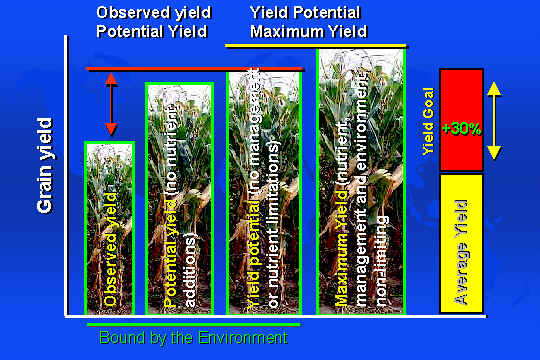
YIELD GOAL was defined by Dahnke et al. (1988) as the 'yield per acre you hope to grow.' They further noted that what you hope to grow and what you end up with are two different things. YIELD GOALs can vary all the way from past average yield to potential yield (Dahnke et al., 1988). They define POTENTIAL YIELD as the highest possible yield obtainable with ideal management, soil, and weather. In our work, what they define as potential yield would be MAXIMUM YIELD, since 'potential' yield is associated with specific soil and weather conditions that can change. Dahnke et al. (1988) concluded that the practical range for a yield goal should be somewhere between above average to near maximum yield obtained by you or a nearby neighbor on a similar type soil. For most farmers, North Dakota State University recommends that the yield goal is the best achievable yield in the last four to five years and that it is usually 30 to 33% higher than the average yield (R. Jay Goos, North Dakota State University, personal communication, October, 1998).
Black and Bauer (1988) reported that the yield goal should be based on how much water is available to the winter wheat crop from stored soil water to a depth of 1.5m in the spring plus the anticipated amount of growing season precipitation. Combining YIELD GOAL, soil test NO3-N and a simple estimate of nitrogen use efficiency can be used to estimate N fertilization requirements. Oklahoma State University generally recommends that farmers apply 33 kg N/ha for every 1 Mg of wheat (2 lb N/ac for every bushel of wheat) they hope to produce, minus the amount of NO3-N in the surface (0-15 cm) soil profile (Johnson et al., 1997). With a yield goal of 2690 kg ha-1 (40 bu/ac) and an average grain N content of 2.36%, estimated total N removed would equal 63.6 kg N ha-1. The nitrogen use (soil N + fertlizer N) efficiency would be 71% (63.6 kg N ha-1 removed /89.6 kg N ha-1 available using a yield goal of 40 bu/ac), which is far greater than the 33% reported for grain production by Olson and Swallow (1984). Even though some of the N-fertilizer needs of the crop can be met by fall applications, the best time to make final N fertilizer adjustments is in the spring before the winter wheat surpasses the 3-leaf stage (Black and Bauer, 1988).
The use of realistic YIELD GOALS combined with soil testing have assisted farmers in estimating preplant and/or in-season fertilizer N needs. When YIELD GOALS are applied, it explicitly places the risk of predicting the environment (good or bad year) on the producer. University extension (e.g., soil testing), fertilizer dealers and private consulting organizations have historically used YIELD GOALS, due to the lack of a better alternative.